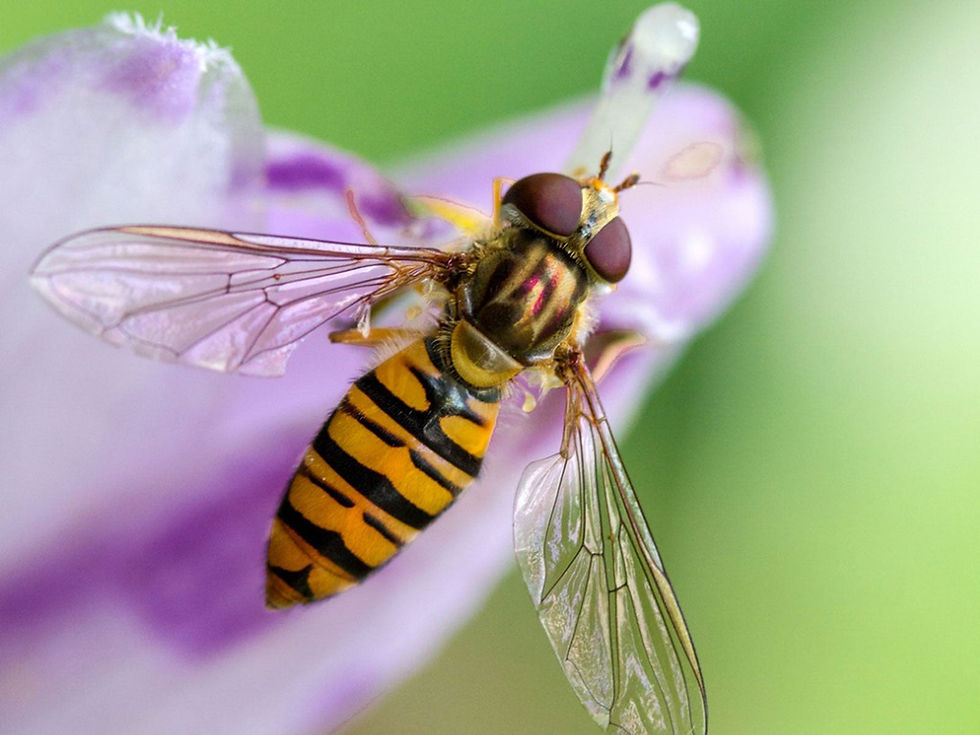Beneficial Insects to Keep Pests Away
- Bethany

- Aug 16
- 3 min read
Not all garden insects bring trouble, and there’s a whole team of beneficial insects working behind the scenes to keep your plants healthy. These beneficial insects are nature’s built-in pest control. They offer vital ecosystem services in exchange for a bit of habitat and a chemical-free environment.

Ground Beetles
Ground beetles are the night-shift predators of the garden. These fast-moving, shiny black or metallic beetles patrol the soil and leaf litter, feasting on slugs, cutworms, and other soft-bodied pests. Their larvae are just as ferocious and live in the soil, where they take down root maggots and other subterranean nuisances.
How to invite them in: Mulch with straw or leaves, and leave a few stones or logs in undisturbed corners for shelter.

Hoverflies
These might look like bees but hoverflies are harmless and in fact are highly beneficial. Their larvae are aphid-eating machines, consuming hundreds during their development. Adults, meanwhile, are important pollinators for vegetables, herbs, and flowers.
How to invite them in: Plant flat, umbel flowers or small clustered flowers such as yarrow, sweet alyssum, dill, and Queen Anne’s lace.

Tachinid Flies
Often overlooked, tachinid flies are some of the garden's stealthiest defenders. Their larvae develop inside host insects like caterpillars, beetles, and sawfly larvae, eventually killing them. While it may sound gruesome, this parasitism helps manage populations of some of the worst garden pests.
How to invite them in: Grow nectar-rich flowers like goldenrod, buckwheat, and coneflowers to support adult flies.

Parasitic Wasps
These tiny warriors specialize in laying their eggs inside or on host insects such as aphids, caterpillars, and whiteflies. As the larvae grow, they consume the host from within. Parasitic wasps play a vital role in natural pest suppression, often going completely unnoticed by the gardener.
How to invite them in: Umbel flowers like parsley, yarrow, and coriander are great nectar sources for adults.

Lacewings
With their delicate green wings and golden eyes, adult lacewings are beautiful but their larvae are the true heroes. Sometimes called “aphid lions,” lacewing larvae have enormous appetites and attack a wide variety of pests, including aphids, thrips, whiteflies, and caterpillars.
How to invite them in: Plant cosmos, coreopsis, and angelica to feed the adults and provide a safe breeding ground.

Spiders
While not technically insects, spiders are invaluable garden allies. Orb weavers, jumping spiders, and ground spiders catch a wide range of pests, including flies, beetles, and even wasps. Contrary to their spooky reputation, most garden spiders are shy and non-threatening to humans.
How to invite them in: Embrace some natural messy corners of your garden and let plants grow thickly, and avoid sweeping away every web.

Ladybugs
The iconic ladybug is a beloved symbol of organic gardening and for good reason. Both adults and larvae devour aphids, mites, scale insects, and mealybugs. A single ladybug larva can eat up to 400 aphids in its short life.
How to invite them in: Provide food sources like fennel, dill, and calendula, and avoid using any pesticides even organic ones that could harm them.
How to Grow a Garden That Welcomes These Beneficial Insects
Plant diverse species especially native plants to ensure continuous blooms throughout the season.
Avoid pesticides, even organic ones like neem oil or insecticidal soap, as they can harm beneficial insects too.
Provide water with shallow dishes or mud puddles for drinking and hydration.
Leave some wild zones like a patch of leaf litter, a log pile, or a evergreen shrubs can be a haven for overwintering insects.
Make space for the "good weeds" like dandelions, clover, and yarrow, which provide early-season nectar and are staple food sourced for many beneficial insects.
By welcoming these tiny allies into your garden, you’re not just reducing your pest problems, you’re supporting a vibrant, balanced ecosystem. The more we learn to work with nature rather than against it, the more resilient, beautiful, and nourishing our gardens become.



